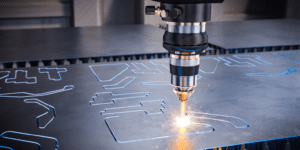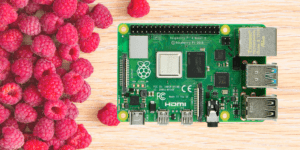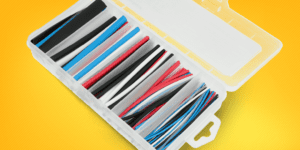Spis treści:
Congratulations, you’ve become the happy owner of a Raspberry Pi 4! Your great adventure has just begun! Time to start a fascinating journey through the possibilities this baby offers you. We will now look at the basic topic. How do you start working on your RPi?
The beginning is not even time-consuming – grab everything from our list and get a cool case if you want. If you are planning to create a small, multimedia command center for ideas or a game console, a pair of headphones or speakers will certainly be a useful addition. Do not waste time and set up your device right now: the immeasurable range of options, limited only by your imagination, gives you the opportunity to create your own games, control robots and other machines, and do many other awesome things. You are on your way to join the growing Raspberry Pi community, exchange ideas and get new inspiration.
What’s waiting for you?
To get started, we need to format our SD card, download the software with a simple NOOBS installer and run the Raspbian installer. Sounds difficult? I am sure you will understand everything right away. The following tutorial will guide you through all the steps to make sure you can use your Raspbian OS, encoding programs and office software without any problems.
What do you need to start your journey with Raspberry Pi 4?
- Well, you certainly need… Raspberry Pi 4, but you also need some other items listed below; if you do not have some of them, you can buy the Raspberry Pi 4 Desktop kit in our store. It contains the computer itself as well as the original Raspberry keyboard and mouse.
- A MicroSD card – at least 8 GB or more. Your Raspberry stores programs and other files on it, and it is used to process files necessary for the operating system. The microSD card reader is also useful for connecting to your computer. Remember to buy a microSD- SD adapter along with the card to connect it to your computer.
- A computer. A Windows or Linux computer or an Apple Mac (the operating system is not that important), which you will use to format the microSD card and download the first software for your Raspberry Pi 4.
- A USB keyboard. Every computer needs a keyboard so that you can send your commands – for example, to direct it to certain web addresses, to create commands or… just control your Raspberry Pi 4. You can also use a Bluetooth keyboard, but the whole process is much easier if you choose a wired one. The Raspberry Pi offers an official keyboard.
- A USB mouse. When it comes to choosing a mouse, the problem is similar to choosing a keyboard – the physical connection (cable) to the USB port offers more favorable conditions than using a Bluetooth mouse. The original mouse from Raspberry is available here.
- A micro HDMI-HDMI cable. Your Raspberry Pi 4 can support two HDMI displays with one micro HDMI-HDMI cable. Do you want to use the one you already have? No problem, all you need is a micro HDMI-HDMI-HDMI adapter, so remember to buy one.
- An HDMI screen. Since having a cable is not enough, you need a display screen as well. A standard monitor from PC is perfect – its large screen will provide you a comfortable display of content. Of course you need an HDMI input to use it. Video cables and connectors are available here.
- Power sources. You may be surprised, but your Raspberry Pi 4 works on the same USB power cable as an average smartphone, so you may have a power source at hand. Use your standard USB type C power supply! However, the recommended justPi USB C power adapter is most reliable.
Connect the keyboard, mouse and display
Okay, we already have everything we need. Now what? Let’s do it together, step by step. The Raspberry Pi 4 has many connectors to make it easy to set up. You can do everything necessary to start the device properly just with a mouse and keyboard.
- Connect the keyboard. A standard PC or Mac keyboard should be connected to one of the four USB A ports on your Raspberry Pi 4. It does not matter which one you use, but we recommend using the black one (USB 2.0) to keep the faster blue one (USB 3.0) for other tasks in the future. As mentioned above, you can also use a Bluetooth keyboard, but we recommend using a wired keyboard.
- Connect the mouse. Connect the wired USB mouse to one of the larger USB A ports left on the Raspberry Pi. As with the keyboard, we recommend using a wired mouse (although it is possible to use a Bluetooth mouse), and leave the faster blue USB 3.0 port free to support other external devices.
- Connect the micro-HDMI cable. You must connect your device to the monitor using a micro- HDMI cable. You can use the micro-HDMI connector on the side of your Raspberry Pi 4 – the standard active HDMI 0 port. The other end of the cable must be connected to the monitor or the TV set you have chosen as your display screen.
Configure Raspberry Pi OS: Raspbian
Not bad. We have already connected everything the way it should be. Now we still have to install the operating system so you can finally start using your Raspberry Pi. The Raspberry Pi uses its own Raspbian operating system based on a Linux variant (Debian Raspbian is the official Raspberry Pi firmware; the easiest way to install it is with the software called NOOBS.
NOTE ! If you have purchased a 16GB microSD card with pre-installed NOOBS software, you can skip steps 1-3. Otherwise you have to format the microSD card and copy NOOBS to this card.
1. Download a tool called SD Card Formatter. We will start by downloading the SD Card Formatter tool from the SD Card Association website. Now insert your microSD card into your PC or Mac and run SD Card Formatter. If the card is not automatically detected, disconnect it, reconnect it, and click Refresh; it should be selected automatically (if not, you can select the right one from the list).
2. Format the microSD. Select the quick formatting option; once the process is complete, the card is ready for use with your Raspberry Pi. Now you can simply leave the microSD card in your computer and select the appropriate signature for the formatted card. Windows usually marks it with a hard drive letter; if you are working on a Mac, the tab appears in a Finder window under Devices.
3. Download NOOBS. Click here to download the NOOBS software (as a zip or torrent file – if you choose the zip file, you will need to decompress it). As we have already explained, NOOBS installs the software of one of the operating systems for Raspberry Pi. Copy all files from the NOOBS folder (not the folder itself!) to your SD card. Eject the SD card as soon as the copying process is complete.
4. Insert the microSD card into your Raspberry Pi 4. Turn your Raspberry Pi over and locate the microSD slot. If the card is inserted correctly, make sure your PC monitor is connected to your Raspberry Pi with an HDMI cable and that the device has access to the mouse and keyboard.
5. Give it some power. Connect your Raspberry Pi to a power source and wait until the screen starts. When the NOOBS installation program appears on your screen, you will see a selection of operating systems in front of you. We will select the first and most popular of them – Raspbian. Check this option and click “Install”, then confirm your choice. For other OS options, click “Wi-Fi networks” and enter your WiFi password. Note that the installation may take a while; then you will be asked to click “OK” and the device will reboot with the Raspbian OS.

6. Welcome in the Raspberry Pi world! Once Raspbian starts for the first time, you will see the splash screen like this:
Make sure you select your time zone and language and create a username and password. Then select your WiFi network, connect to it and allow Raspbian to complete all necessary OS updates. You may then be prompted to restart your device to complete the update. Done! That was not so difficult, was it? Now you can enjoy the amazing and beautiful new world that has just opened up for you!
How useful was this post?
Click on a star to rate it!
Average rating 5 / 5. Vote count: 1
No votes so far! Be the first to rate this post.










